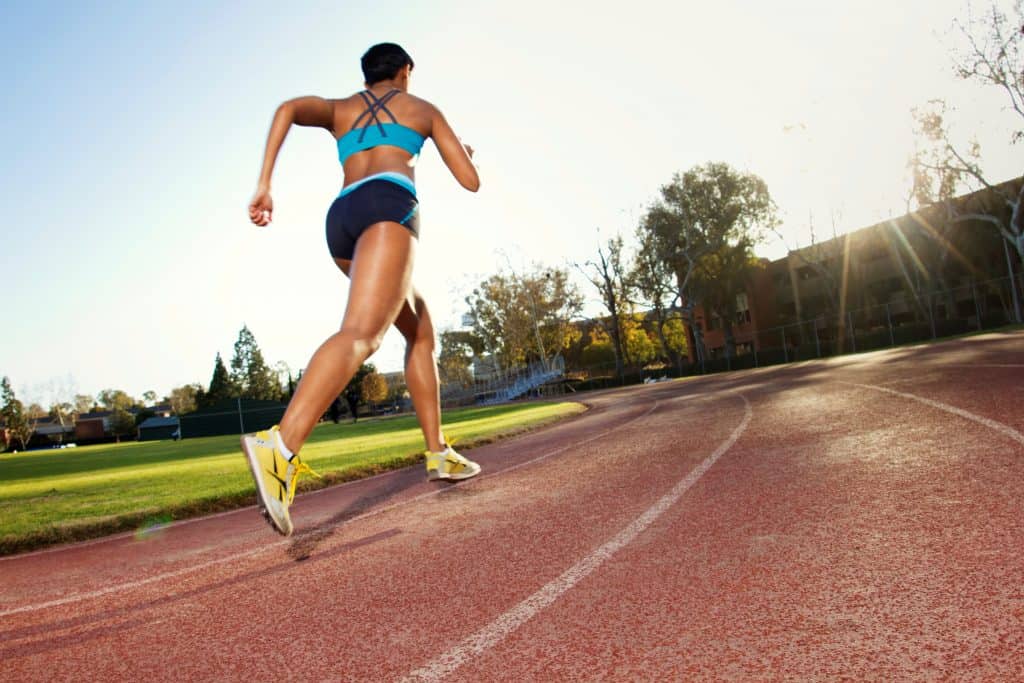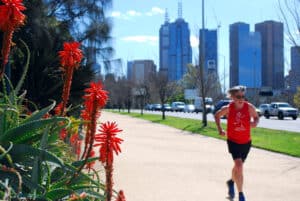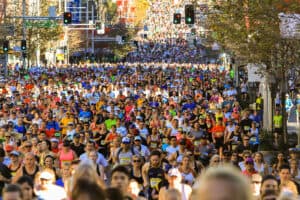Athletics tracks are fantastic training grounds for runners of all abilities. Whether you’re looking to improve your speed, build endurance, or simply enjoy the benefits of a smooth, predictable surface, the track can be a welcoming and effective place to train. However, with many athletes of different types using the facility, understanding track etiquette is crucial to ensuring a safe and enjoyable experience for everyone.
In this article (6 minutes)
Why Run on a Track in the Australian Summer?
Summer in Australia means long, sun-drenched evenings and early morning sessions before the heat sets in. With less big events to run in, the variety of running on the track during this time offers some key benefits:
Measurable progress – A standard athletics track is 400 metres, making it easy to track distance, pace, and improvement over time.
Consistent surface – Unlike uneven trails or busy roads, a track offers a predictable and even surface. Synthetic tracks are a fast surface to run on, while grass tracks provide a more cushioned surface.
Safe environment – Free from traffic, cyclists, and unexpected obstacles, the track is a controlled space for focused training.
Escape the harsh sun – Early morning and late evening track sessions provide relief from the most intense hours of sun exposure, helping to prevent heat exhaustion and sunburn. Many tracks also have lights, allowing for night training when temperatures are lower.
Community atmosphere – Many runners and clubs train at tracks, providing opportunities for social running and motivation.
Perfect for speedwork – The flat, even surface of a track is ideal for faster running or high-intensity workouts that might be difficult to execute on uneven or unpredictable terrain.
Key Track Etiquette for Runners

There can be a lot going on at an athletics track – throwers, jumpers, sprinters and runners are all very different – and who all need to share the space to make it all work.
To keep the track a welcoming and safe space, it’s important to follow some basic guidelines:
1. Understand Lane Usage

Athletics tracks are designed to be run in an anti-clockwise direction. But not all lanes are used the same way in training. Always check what is going on, but as a general rule of thumb:
Inner lanes (1-2): Typically used for sessions where a lap or more is being run at a time. For anything shorter, outer lanes can be used. Some tracks have gates that block these lanes to prevent wear and tear, which should be respected.
Middle lanes (3-6): Used for sessions where less than a lap is being run at a time, with staggered markings on the track guiding where to start from. Pay attention to sprinters, particularly when entering the straights, who may be using these lanes.
Outer lanes (7-8): Best for slower jogging (even better is to jog just outside the outside lane) – and pay attention for sprinters (and hurdlers).
If in doubt, observe other runners or ask regulars where you should run.
2. Look Before You Cross
Just like crossing a road, check both ways before stepping onto the track. Faster runners may be completing reps and may not have time to react to sudden movements.
Beware of the infield – where throwers may be active or where high jumpers or long jumpers might be training. Never run through areas being used by field event athletes.
3. Pay Attention and Yield to Faster Runners
There can be a lot going on at an athletics track, with runners of dramatically different paces using the venue. Remaining aware of your surroundings is key, so the track is no place for headphones.
If someone is coming up behind you, let them pass without shifting erratically. If you hear “Track!” or “Coming through!” be aware and hold your line.
4. Avoid Stopping in Active Lanes
If you need to pause, adjust your watch, or chat with a friend, step off the track or move to the outer lanes to avoid blocking others.
5. No Standing or Stretching on the Track
Warm up and stretch off to the side. Keeping the track clear ensures everyone can run smoothly without unnecessary obstacles.
6. Hydration and Heat Management
Australian summers can be brutal and in particular, synthetic tracks retain a lot of heat, so bring plenty of water. If training in peak heat, stick to shaded areas for recovery and avoid overheating. Wearing light-coloured, breathable clothing can also help regulate body temperature.
If you’d like to learn more about athletics track etiquette the Australian Athletics Directory has a more detailed guide.
Types of sessions you can do on a track

Using the track effectively can add variety and structure to your training. Finding a running coach or a run club – many incorporate track sessions – is a great way to go about things. But if you’d like to dip your feet in by yourself first, there are some common workouts suited to runners of all levels:
Fartlek
Fartlek is a Swedish word meaning ‘speed play.’ It can be done anywhere and in its purest form isn’t about measuring time or distance e.g. in a park it might be running hard to a certain landmark, jogging or ‘floating’ to another, surging up a hill etc
However, on a track it can be done in a more measured way to measure consistency of effort.
Example: Alternate running 1 lap hard, 1 lap easy for 20-30 minutes.
Example: Running the straights of the track ‘hard’ and ‘floating’ (not jogging, running at a good tempo) on the bends.
Short repetitions
The idea behind this training is to run multiple repetitions at a fast pace, with a recovery interval between. This way the same or even greater distance volume can be covered than would be possible than if the entire distance was being run continuously.
There’s infinite variations to this type of training, varying the length of the repetition and the length of the recovery (and the pace any running during the recovery is done at).
Example: 8 x 400m at a strong effort (think faster than your 5km pace) with 200m slow recovery jog between each.
Long repetitions
Great for getting hard work in as well as learning to pace yourself during events.
Example: 5 x 1000m at 5km race pace with 2-minute recovery jogs.
Pyramid workouts
This is a variation that combines short and long repetitions, which is great for variety. The different distances can be run at different paces, or at the same pace, depending on what you want to achieve from the session.
Example: 200m, 400m, 800m, 400m, 200m with equal time for the recovery as spent running each repetition
Time Trial
When you want to test your fitness and there’s not an event available. 3000m (7 ½ laps) is a great distance to test yourself at, as is 5000m (12 ½ laps).
Making the track a welcoming space for all

Athletics tracks are not just for elite runners—they are a community resource for anyone looking to improve their fitness. By following good etiquette and being mindful of other users, runners can benefit from the many advantages of track training while contributing to a positive community atmosphere.
Some tracks are open to the public at all times, while others have open community nights or club sessions where newcomers can join in without feeling intimidated. If you’re unsure where to start, joining a local running group or track session can help ease you into structured training in a supportive environment.
Find your closest athletics track

Find your closest athletics track at the Australian Athletics Directory.




